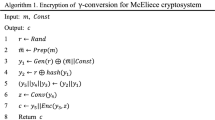Abstract
An encrypting block low-density parity-check code based on quadratic permutation polynomials (QPPs) (QPP-Block-LDPC) is proposed in this paper. The parity-check matrix of the encrypting QPP-Block-LDPC code is composed of a group of permutations, which can be mapped to QPPs. The coefficients of the QPPs, which are served as secret keys, are utilized to randomize the permutation submatrices. A secure channel coding scheme is presented using the QPP-Block-LDPC code to produce the error-correcting ciphertexts. The coding can achieve more efficient implementation and provide an acceptable security level for the communication over the Gaussian wiretap channel. Simulation results demonstrate that this coding offers good trade-offs between the error performance and the security level.





Similar content being viewed by others
References
Jacques, J. A. F. (2007). Vector microprocessors for cryptography. Cambridge: Cambridge University Press. 2007.
Mceliece, R. J. (1978). A public-key cryptosystem based on algebraic coding theory. DSN Progress Report, 42–44, 114–116.
Berlekamp, E. R., McEliece, R. J., & Van Tilborg, H. C. A. (1948). On inherent intractability of certain coding problems. IEEE Transaction on Information Theory, 24, 384–386.
Rao, T.N.R.(1984). Joint encryption and error correction schemes. Proceedings of 11th annual International symposium on Computer architecture. Ann Arbor, USA, 1984, (pp. 240–241).
Rao, T. R. N., & Nam, K. H. (1987). Private-key algebraic-code encryption. IEEE Transaction on Information Theory, 35(4), 829–833.
Struik, R., & Tilburg, J.(1988). The Rao-Nam scheme is insecure against a chosen-plaintext attack. Advances in Cryptology, Crypto 87. Santa Barbara, (pp. 445–457).
Sun, H.M., & Shieh, S.P.(1988). On private-key cryptosystems based on product codes. Proceedings of 3rd Australasian Conference on Information Security and Privacy. Brisbane, (pp. 68–79).
Barbero, A.I., & Ytrehus, O.(1998). Modifications of the Rao-Nam cryptosystem. Proceedings of International Conference on Coding Theory, Cryptography and Related Areas. Guanajuato, Mexico, 1998, (pp. 1–13).
Xu, L. (2003). A general encryption scheme based on MDS code. Proceedings of IEEE International Symposium on Information Theory 2003. Yokohama, Japan, 2003, (pp. 7–11)
Baldi, M., & Chiaraluce, F. (2007). Cryptanalysis of a new instance of McEliece cryptosystem based on QC-LDPC codes. In Proceedings of IEEE International Symposium Information Theory 2007, Nice, France (pp. 2591–2595).
Mackay, D. J. C. (1999). Good error correcting codes based on very sparse matrices. IEEE Transaction on Information Theory, 45(1), 399–431.
Zhong, H., & Zhang, T. (2005). Block-LDPC: a practical LDPC coding system design approach. IEEE Transaction on Circuits and Systems-I: Regular Papers, 52(4), 766–775.
Tao, X., Zhou, X., Feng, D., & Zheng, L.(2011). Circulant search algorithm for the constructon of QC-LDPC codes. Proceedings of IEEE International Conference on Broadband Network and Multimedia Technology (IC-BNMT), Shenzhen, China (pp. 18–191).
Guan, W., & Liang, L. P. (2015). Construction of Block-LDPC codes based on quadratic permutation polynomials. Journal of Communications and Networks, 5(3), 48–52.
Sobhi Afshar, A. A., Eghlidos, T., & Aref, M. R. (2009). Efficient secure channel coding based on quasi-cyclic low-density parity-check codes. IET Communications, 3(2), 279–292.
Baldi, M., Bianchi, M., & Chiaraluce, G. F. (2013). Security and complexity of the McEliece cryptosystem based on quasi-cyclic low-density parity-check codes. IET Information Security, 7(3), 212–220.
Baldi, M., Chiaraluce, F., Garello, R., & Mininni, F. (2007). Quasi-cyclic low-density parity-check codes in the McEliece cryptosystem. IEEE International Conference on Communications (ICC2007), Glasgow, Scotland (pp. 951–956).
Wyner, A. D. (1975). The wire-tap channel. Journal of System and Technology, Bell, 54(8), 1355–1387.
Klinc, D., Ha, J., McLaughlin, S., Barros, J., & Kwak, B. J. (2011). LDPC codes for the Gaussian wiretap channel. IEEE Transaction on Information Forensics Security, 6(3), 532–540.
Wong, C. W., Wong, T. F., & Shea, J. M. (2011). Secret-sharing LDPC codes for the BPSK-constrained Gaussian wiretap channel. IEEE Transaction on Information Forensics Security, 6(3), 551–564.
Beker, H., & Piper, F. (1982). Cipher systems: The protection of communications. Hoboken: Wiley-Interscience. 1982.
Sun, J., & Takeshita, O. Y. (2005). Interleavers for Turbo codes using permutation polynomials over integer rings. IEEE Transaction on Information Theory, 51(1), 101–119.
Arabaci, M., Djordjevic, I. B., Saunders, R., & Marcoccia, R. M. (2010). Polarization-multiplexed rate-adaptive non-binary-quasi-cyclic-LDPC-coded multilevel modulation with coherent detection for optical transport networks. Optical Express, 18(3), 1820–1832.
Author information
Authors and Affiliations
Corresponding author
Additional information
This work was supported in part by the National Natural Science Foundation of China under Grant No. 61471354.
Rights and permissions
About this article
Cite this article
Guan, W., Liang, L. Efficient Secure Channel Coding based on QPP-Block-LDPC Codes. Wireless Pers Commun 98, 1001–1014 (2018). https://doi.org/10.1007/s11277-017-4905-9
Published:
Issue Date:
DOI: https://doi.org/10.1007/s11277-017-4905-9




